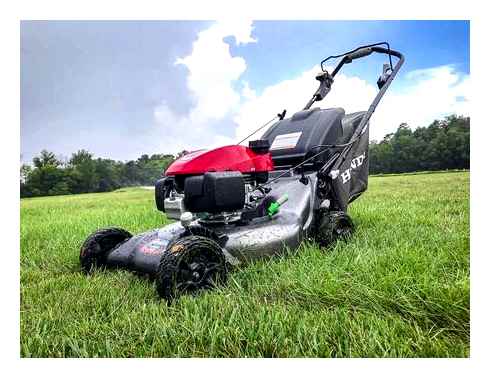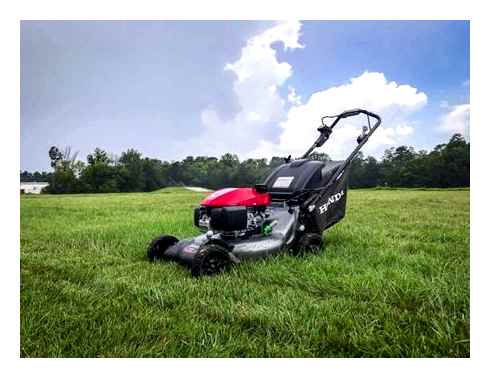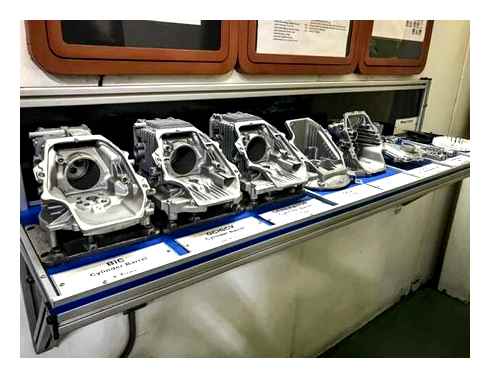Honda HRN216 Lawn Mower Series

Honda Power Equipment celebrated their 35 th anniversary with plenty of fanfare and with the launch of the all-new Honda HRN216 lawn mower series. This mower is built new from the ground up as a replacement for their most popular line of consumer mowers.
Honda HRN216: Replacing the Honda HRR216 Lineup
When you sell 300,000 lawn mowers a year from just one line, normal thinking says to keep crankin’ ’em out. But Honda Power Equipment isn’t satisfied to sit still and they’re replacing the HRR216 series with the Honda HRN216 line.

To put that into perspective, it’s like Honda replacing the Civic with an all-new model. They sell 300,000 Civics and HRR216’s every year.
Power Plant
The biggest difference for the Honda HRN216 is the engine – a completely rebuilt GCV170 engine. It moves from 106 parts down to just 39. It’s easier to service, has better fuel efficiency, 9% higher power, and 18% more torque than the GCV160 it replaces.

It also features an all-metal transmission, something that’s uncommon for this class of lawn mower. Because Honda manufacturers both the engine and the transmission, it’s a perfectly designed fit. Other options often pair an engine and transmission from different manufacturers that they have to make fit.
It’s still a residential engine, just a more powerful one. It still fits the same footprint from the GCV 160, allowing it to mate to the same equipment. Here are a few of the smaller changes that make a difference:
Honda HRN216 Performance Features
The Honda HRN216 series comes with Honda’s twin-blade design, making it more effective at mulching. When you bag, the clippings are smaller and you get more grass in the bag so you’re stopping to empty less often.

They also increased the chute diameter, making it tougher to clog. In Honda’s internal testing, the new design made a fast 5” cut 131′ – more than double the distance the HRR 216 made before clogging (62′).
We were all set to do some high-quality cutting in Honda Power Equipment’s backyard when a thunderstorm interrupted us. I did get to cut for about 15 minutes and it’s pretty impressive in wet grass on a regular maintenance cut. We’ll do some more thorough testing, including in taller grass when it arrives at our world headquarters.

If you’re familiar with Honda’s HRX mowers on the commercial side, the 3-in-1 Clip Director makes its way over to the new line. This is a lever that closes off exit airflow for mulching. If you want to bag or use the rear discharge, flip it over to the bag setting and roll. There’s no plug to worry about.
Here are a few minor fixes compared to the HRR216
Other Features
Sleeker Design
A side-by-side look at the HRR and the HRN216 shows that Honda is going after a sleeker, sexier design is an improvement over the previous utilitarian look.
The design team goes with a 2-point height adjustment system – one lever on the front axle and a second on the rear. Using a rivet to connect the solid rod to the wheels, it creates a rigid construction that resists the torsion you often see from a 2-point or 1-point design.

As an added bonus, you can tilt the front end up a notch and bag more effectively than when all 4 wheels are level.
Combined with its heavy-duty 21” steel deck, it’s a solid, durable machine.
Rise and Drive
There are 7 height adjustment levels covering 1” to 4” cutting heights (1.06″ to 3.93″). Conveniently, each height marking corresponds to the height and it’s a high-contrast white on black so you can see it easier.
For the self-propelled models, there’s a big change in the drive operation. The Smart Drive push bar under the main handle lets you feather your speed from 0 – 4 MPH. It’s broad enough to easily use with your thumbs so your other fingers can keep the presence bar engaged.

A slide in the middle of the thumb bar allows you to adjust it into 5 positions moving up the bar. Chances are, you’ll find a comfortable position to settle on. Once you do, adjusting your speed comes very naturally as you work your way around the yard.
The goal was to reduce thumb fatigue with better ergonomics. In the short period of time that I got to use it, it seems to work. We’ll test it for a longer period once we get one in for a full review.
One upgrade that was immediately apparent was the 2-way ratchet system on the drive. When you release the drive bar, a key in the drive allows the rear wheels to freewheel in forward and reverse. The HRR only had forward freewheeling. When you’re working around landscaping or corners where you need to pivot frequently, it’s really noticeable.
Additional Features
Born in the USA
I’d be remiss if I didn’t point out Honda’s USA-based manufacturing. While not every component comes from the US, most of the engine and mower parts are manufactured in the Swepsonville, NC facility we visited. The entire mower is assembled at that plant and it was the same facility that the product team conceived and designed it.

Looking more broadly at Honda’s American facilities, there’s an impressive commitment to manufacturing in the US and North America in general. Many of the cars and products they make have more USA in their DNA than American companies that source a lot of the work elsewhere.
Expect the Honda HRN216 line to see limited distribution starting in September 2019, with a bigger push to retailers this winter.
Honda HRN 216 Lawn Mower Models
Shared Specifications
- Completely redesigned Honda GCV170 engine (167 cc)
- Auto choke system
- 0.237-gallon fuel tank (0.9L)
- 8″ tires
- 21″ Steel/resin deck
- 7-position, 2-point deck height adjustment
- 1.06″ to 3.93″ cutting height range
- Mulch/bag/rear discharge with Chip Director
- 17-gallon bag
- 2 handle positions
- Twin blade cutting system
Honda HRN216 PKA
To get the benefits of the HRN216’s redesign without the self-propelled drive, go with the PKA version.
Honda HRN216VKA
The VKA version is the most basic of the self-propelled versions. It uses a recoil start with the rear-wheel drive Smart Drive system.
Honda HRN216VLA
The VLA has a keyed electric start that is mounted on the handle where you see many self-propelled speed adjusters on other mowers. Like we expect, there’s a recoil backup if the battery dies.
Honda HRN216VYA
The VYA is the top of the Honda HRN216 line. It includes Roto-Stop—a feature we see on the HRX that lets stops the blades without stopping the engine. It’s helpful for times that you need to move a stick out of the way, empty the bag, or prod a stubborn alligator back into the lake. The big deal is it saves you from having to restart the mower after every interruption.
Switching Blades from a HRN model to the HRX model Blades?
I just purchased a Honda HRN216VKA Lawn Mower. So far I love it! But I have a question about swapping blades. The HRX217VKA model has the 4-in-1 Versamow system that consists of a notched bag/mulch lever and a different main blade that has different ends. I assume it is for better mulching and leaf pickup. What I want to know is can I use the blades from the HRX217VKA model in my HRN216VKA model? The holes in the blade and the size of the blades look the same in the pictures. I can figure out a way to keep the mulch door open or closed at varying levels. I have used better Mulching blades on my Rider mower and other push mowers with great results. What is interesting is that the previous model of the version of mower I purchased (HRR216VKA) uses a blade that looks just like the HRX217VKA Blade.
How We Tested and Selected
We compiled this list based on Popular Mechanics mower testing and our knowledge of the lawn mower market at large. For our testing, we put mowers through the paces using our standard Popular Mechanics methodology: We cut turf grasses such as fescues and blue grass and rougher non-turf grasses like Timothy, clover, orchard grass, and wild oats, all in both normal and shin-deep heights. We mow uphill, downhill, and across the faces of hills. The maximum slope we cut is about 30 degrees.
That may not sound like much, but it’s about all you can do to stand on it, let alone push a mower up it or across it. We mow damp and wet grass to test general cutting performance and whether clippings accumulate on the tires. And we cut dry and dusty surfaces to see how well the bag filters under less-than-optimal conditions.
Key Specs
Honda mowers enjoy a sterling reputation. Having tested their walk and self-propelled mowers for the last 30 years, we feel confident that Honda’s entry level mower is a great choice for homeowners looking for power and durability. The HRN features a GCV 170 gas engine that’s built to withstand long hours of operation.
If you do your own maintenance (and most owners who buy this class of product do), you’ll appreciate the easily accessible spark plug and the fuel shutoff valve that enables better winter storage. Close the fuel shutoff and run the mower until it sputters to a halt. This will clear the carburetor of any gasoline, which will prevent the ethanol in it from disintegrating and causing running issues later on. Open the shutoff valve in the spring, add some fresh gasoline, and the mower should start easily.
All this maintenance stuff is great, but we can also tell you that our past test findings on other Hondas prove that their cut quality is outstanding for cleanliness. Sharp blades deliver a velvet-like finish. And their bagging ability is also quite good, in the same league with other well-bagging mowers from Toro.
In all, if you take mowing seriously, you should enjoy this Honda. If you have a little wiggle room in your budget, consider the Honda HRX, which features a mower powerful engine and a composite deck that won’t rust and is renowned for its durability.
One note is that Honda has announced that it will cease selling lawn mowers in the United States after this year—so if you’re considering buying one, best do it sooner rather than later.
Key Specs
Toro mowers have garnered more recommendations from us than any other brand for two reasons: build quality and cut quality. These were amply demonstrated in our testing as the Recycler turned in the best ratio of cut area per amp-hour of battery in the self-propelled category, while at the same time not skimping on cutting, mulching, or bagging quality.
Next, the company’s redesigned “Atomic” blade configuration appears to assist the air flow and clipping movement. Finally, the three-phase, 60-volt motor is exceptionally efficient, resulting in a large cut area for a single battery.
Toro has maintained features that make this mower work: rear wheel drive, a one-piece deck that’s all steel (no plastic nose), 11-inch wheels to help it roll over roots and crevices, and the same fold-forward handle that was an industry breakthrough when it was introduced some years ago.
Key Specs
This is one of Ryobi’s top-of-the-line mowers, and it’s American-made construction is something we wish we saw more of. It delivers a tremendous cut area with its two 6-Ah batteries providing a total of 12-Ah of capacity, and its X-shaped blade leaves a pristine surface in its wake.
Ryobi estimates the design should provide 70 minutes of run time; we didn’t time our cut, but it strikes as plausible. Its rear-wheel drive and reasonably aggressive tire tread pattern provide good hill climbing and sidehill cutting performance, and its bagging on all surfaces (level, sidehill, and uphill) is also commendable.
Other ease-of-use features include an easily installed or removed bag that mounts and dismounts straight up and down through the handle; deck adjustment is quick and easy thanks to a single-level deck height adjustment. The straight edge deck is polypropylene; it will never rust and needs very little care other than basic cleaning.
Toro TimeMaster 30 in. Briggs Stratton Personal Pace

The Toro Timemaster 30-in. mower has been around for several years and has earned a reputation as a sturdy workhorse for homeowners who want to cut down on their mowing time. It’s also used by some professionals as well. A few years ago the Timemaster got a slightly more powerful Briggs and Stratton gas engine, so it should have no issues powering through most demanding mowing jobs.
The Timemaster is rear-wheel drive and features Toro’s Personal Pace drive system that’s used on many of its self-propelled mowers. This allows the mower to move at your speed by simply pushing down or releasing the handle, which is spring-tensioned.
With a 30-in. deck, Toro claims the Timemaster will help you reduce your mowing time by about 40% compared to using a standard-sized mower. You can mulch, back, or side discharge with the Timemaster, and the handlebar can be locked in a fully vertical position to reduce space consumption in storage.
If you have half an acre to a full acre of lawn to mow and prefer the experience of a walk-behind mower versus a tractor or zero-turn, the Timemaster is worth a look.
Craftsman mowers have been doing very well in our tests, so we can recommend this one because it’s so much like the many other of the brand’s models that we’ve tested. If you’re looking for a good blend of maneuverability and power, you’ll get it with this mower. Its front drive helps move it along and makes it easy to turn.
It’s important to note that front-drive mowers do lose some traction when running uphill, particularly with a full grass bag. But if your slope is less than 20 degrees, and you’re not bagging uphill, you’ll be fine. The side discharge will also help you handle tall grass. Adjust the two deck levers to bring the mower up to full height and have at the rough stuff.
The fact that this mower bags, mulches, and side discharges is a plus, enabling you to handle a wide range of mowing conditions, from early spring and late into the fall. Three-function mowers like this are our preference for that versatility.
Key Specs
This is a beauty of a mower, with a cast-aluminum deck and a smooth-running Briggs Stratton 163-cc engine. We tested the Honda engine-equipped version, and it was effective at both bagging and mulching, even in moist grass.
Equipped with rear-wheel drive and the Personal Pace system (the farther you push the drive bar, the faster the mower goes), it’s an effective hill climber and moderately effective on sidehill cutting. It has relatively small 7.5-inch tires on all four corners, which causes this Toro to bump up and down a bit on washboard surfaces. But the good news is that it’s equipped with a far higher quality tire than we’re used to seeing these days. We didn’t notice them pick up any grass on moist surfaces.
Other features we like include its forward-fold handle that has a built-in shock absorber that Toro calls a Flex Handle Suspension, and a high-quality grass bag that loads through the handle, from the top.
QA
Are there special maintenance considerations with self-propelled mowers?
Yes. Both front- and rear-wheel drive mowers typically feature a drive belt, which can crack or wear out over time. Fortunately these belts are not difficult or particularly expensive to replace.
Secondly, you may have to replace the drive wheels occasionally. These wheels are driven with gears. there are typically teeth on the inside diameter of the drive wheel that line up with a gear on the axle. These teeth can wear out, especially if they are made of plastic. Higher-end mowers may feature drive wheels with a metal gear that meets the metal axle gear, which improves longevity of these components.
My lawnmower says I don’t ever have to change the oil, but just add oil when needed. Is this OK?
It’s not a good idea to never change the oil in your lawn mower. In a lawn mower, same as a car, oil degrades over time and is less effective at reducing heat and friction in metal components. Changing the oil in your lawn mower is easy to do and will significantly increase its service life. For most homeowners, changing the oil at the beginning or end of each mowing season should be sufficient, though there is certainly no harm in doing it more often.
Roy Berendsohn has worked for more than 25 years at Popular Mechanics, where he has written on carpentry, masonry, painting, plumbing, electrical, woodworking, blacksmithing, welding, lawn care, chainsaw use, and outdoor power equipment. When he’s not working on his own house, he volunteers with Sovereign Grace Church doing home repair for families in rural, suburban and urban locations throughout central and southern New Jersey.